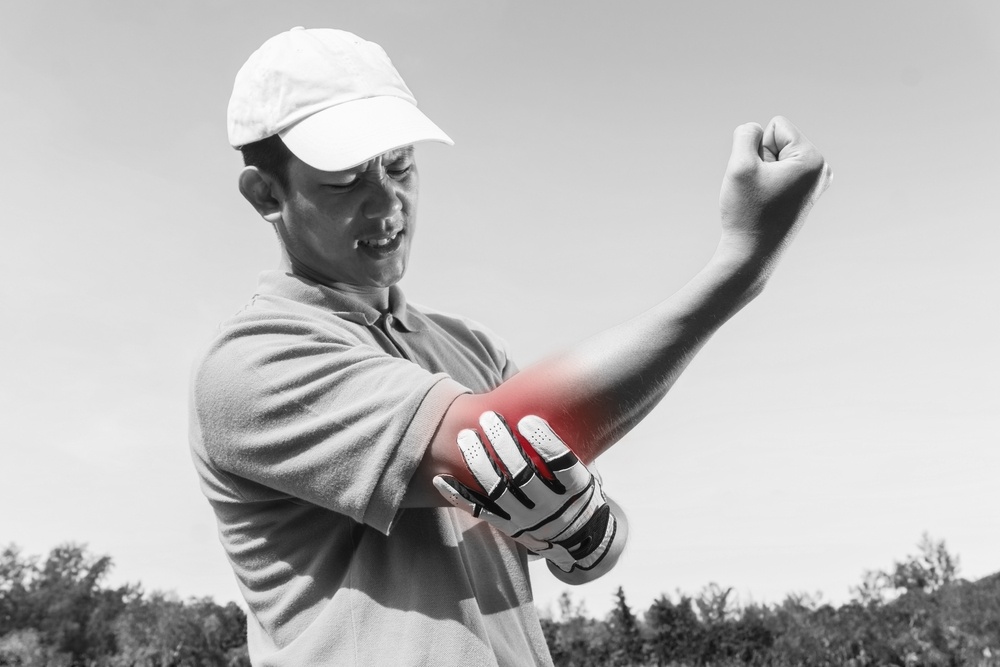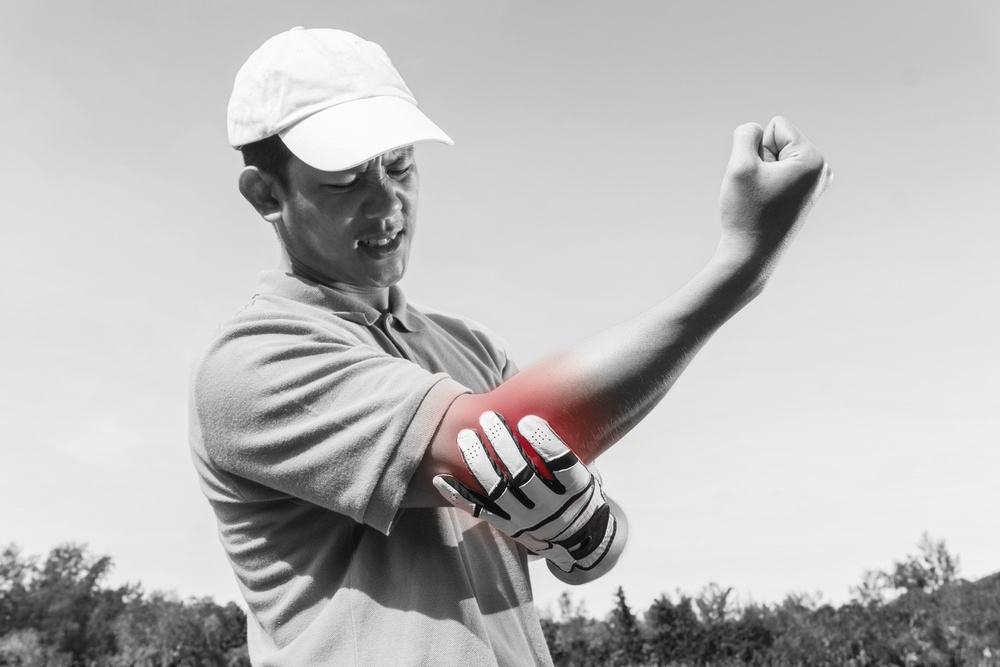What is Golfers Elbow? (Symptoms, Causes, and Treatment)
September 13th, 2018 | 4 min. read


Golfer's elbow, also known as medial epicondylitis, is a common sports tendonitis injury where you experience pain at the point where your forearm muscle tendons attach to the inside of your elbow on the bony bump. The pain may radiate into your wrist and forearm.
Medial epicondylitis is similar to tennis elbow, which affects the outside of your elbow, and involves inflammation. Golfers aren't the only people to develop it golfer’s elbow. Individuals like tennis players who clench their fingers and use their wrists repeatedly may also develop golfer's elbow.
Painful medial epicondylitis doesn't have to keep you from enjoying your favorite activities — or keep you from playing golf. Appropriate treatment, which you can receive from the experts here at Coastal Orthopedics, can help you get back to normal.
Symptoms of Golfer's Elbow
Golfers elbow symptoms generally include:
-
Tenderness and pain on your inner side of your elbow. In some cases, the pain can spread along your forearm's inner side. Certain movements worsen the pain.
-
Weakness. You might experience weakness in your wrists and hands.
-
Stiffness. Your elbow might hurt to make a fist and feel stiff.
-
Numbness or tingling. You may experience these sensations radiating into your fingers, typically the little and ring fingers.
Golfer's elbow pain can come on gradually or suddenly. It may become worse when you:
-
Shake hands
-
Swing a racket or golf club
-
Lift weights
-
Pitch or swing a ball
-
Pick an item up with your palm down
-
Turn a doorknob
-
Flex your wrist
Golfers Elbow Causes
There are numerous golfers elbows causes. The excessive force you use when you bend your wrist toward your palm can cause the condition. Other potential causes of golfer's elbow include:
-
Weak wrist and shoulder muscles
-
Using a spin serve or serving with great force
-
Carrying a heavy suitcase
-
Throwing a javelin
-
Operating a chainsaw
-
Chopping wood with an ax
-
Using other hand tools frequently
-
Using a too heavy, too short, too tightly strung tennis racket
Some individuals might be at risk due to the activities they perform at work. If the activities involve continual bending or twisting of the wrist, it can cause tendon strain.
Individuals in occupations of high risk include:
-
Plumbers
-
Butchers
-
Cooks
-
Regular computer users
-
Construction workers
-
Painters
-
Assembly line workers
Whenever you experience an unexplained, lingering pain, you should consult with a doctor to determine what's causing the pain and receive treatment.
If the doctor can determine what activity is causing your golfer's elbow, when you stop this activity, it can reduce the pain eventually.
Rest will usually result in improvement when you have golfer’s elbow. But, if you have severe symptoms or when dedicated rest only provides you with limited relief, you should see their doctor, particularly a orthopedic and sports medicine specialist who has experience and training in diagnosing and treating golfer’s elbow.m
Golfers Elbow Treatment Options
Doctors generally perform a physical exam to diagnose golfers elbow. During your appointment, the orthopedic specialist will check your wrist, elbow and fingers to see the extent of which you can move them.
Our physician might also take an X-ray to help them rule out other conditions such as an elbow fracture. The X-ray is a painless, quick imaging test that allows the doctors to take images of your internal structures and bones.
After diagnosis:
The doctor will usually try to treat the condition with non-surgical methods first. These methods typically help you recover within a few months. Some non-surgical treatments may include:
-
Ice: Putting ice on your elbow a few times a day for around 20 minutes can help relieve your pain in your elbow.
-
Rest: Sports activities and repetitive motions may worsen golfer's elbow. Our doctor may also have you wear a brace on your arm.
-
Pain medication: Ibuprofen (Advil), acetaminophen (Tylenol), naproxen sodium (Aleve) and other over-the-counter medicines may reduce inflammation and pain. In more severe cases, your doctor may prescribe you a stronger pain reliever.
-
Physical therapy: During physical therapy, a physical therapist can show you different exercises to strengthen and stretch your muscles to help speed your recovery up.
Exercises
Stretching and exercising arm muscles can help heal or prevent golfer's elbow. Ask the physical therapist or doctor about the types of exercises that can help. They will provide you with more individualized recommendations such as:
- Finger Extensions: You'll squeeze all five your fingertips together, stretching a rubber band around them. Then extend your fingers as far away from each other as the rubber band will allow.
- Ball Squeezes: With squeezes, you'll perform a simple exercise involving a stress reliever or ball. You'll put the ball in the affected hand's palm and make a fist around the ball. Then squeeze and release the ball in repetition to strengthen your forearm.
- Forearm Pronation and Supination: With this exercise, you'll hold a heavy item, like a hammer. Lay your damaged forearm on your knee or a table for stability. Hold the hammer (or another item) so your palm is parallel to your body. Then, rotate your hand so your palm faces downward. Go back to the original position and rotate your hand so your palm now faces the ceiling.
- Wrist Extensions: Before you perform this exercise, you'll need to obtain a one-pound weight. Place your damaged forearm on your knee or a table, suspending your hand over the edge. Put the weight in this hand and hold it while you slowly lift and lower it.
Surgery
Surgery is needed in rare cases for golfer’s elbow, but particularly if you're still experiencing elbow pain after a year. Our orthopedist surgeons here at Coastal Orthopedics are experts and experienced in minimally invasive arthroscopic surgery. With this procedure, our surgeon makes tiny incisions and use flexible, thin tools to repair the damage. Arthroscopic surgery offers minimal scarring and faster recovery than traditional, open surgery.
Your chances of full recovery from golfer’s elbow are good. You have a better chance of recovering quickly if you stop the activity causing the condition as soon as your symptoms begin. Follow all the instructions our doctor provides you exactly as they directed.
Also, continue to stretch the arm, apply ice to the injury and practice strengthening exercises to help promote healing and prevent a golfers elbow recurrence.
Get Evaluated and Treated for Golfer’s Elbow in corpus Christi, Texas today!
If you love to play 18 holes of golf, and you’ve developed golfer’s elbow, you no doubt want to get back on the course as soon as possible. Therefore, if you suspect you have golfer’s elbow or another sports or recreational injury, call (361) 994-1166 to set up an appointment at Coastal Orthopedics in Corpus Christi, Texas for a diagnosis and treatment.
Article written by: Rob Williams, MD
`
Dr. Williams has been practicing orthopedic surgery in Corpus Christi since 1998. After graduating from Texas Tech hereceived his medical degree from the University of Texas at San Antonio. At the prestigious Campbell Clinic located at the University of Tennessee, Dr. Williams completed not only an Orthopedic Surgery Residency, but an additional year of Fellowship Training in Spine Surgery. Dr. Williams is dedicated to creating an excellent patient experience in the office or in the surgery suite.
Topics:

